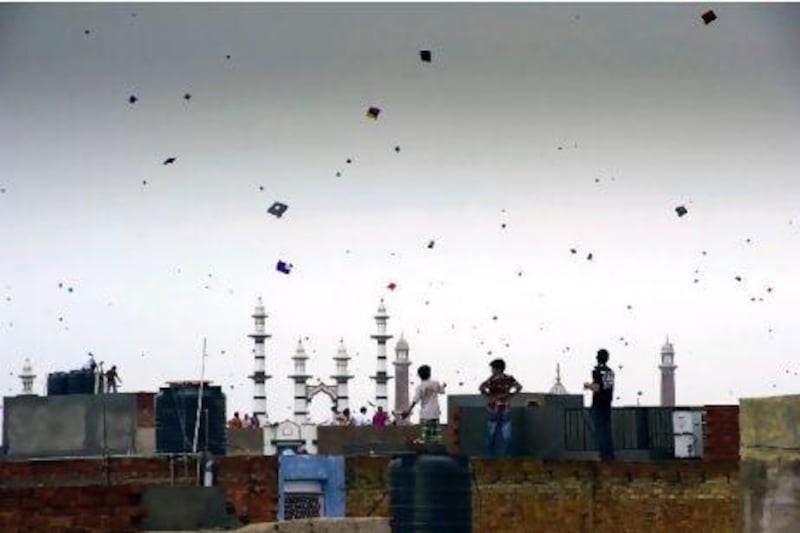NEW DELHI // Pratyaksh Gupta has a suitcase full of trophies. The 13-year-old is masterful with a kite and the 50 or so kites in it are his proof. He won them by cutting the lines of his opponents in pitched kite battles fought from the roof of his building in Old Delhi.
Kite flying and kite battles, using a patang, or a fighter kite, are an Independence Day tradition in Delhi. From early afternoon until sunset, thousands of kites seemingly outnumber the birds in the sky.
In pictures: India marks 64 years of independence
The normally packed roads are empty on Independence day, as residents of Chandni Chowk, the oldest market in the ancient walled city of Old Delhi, crowd their rooftops to fly and fight each others' kites. All eyes look skyward, as tens of thousands of kites dance around each other. For as far as the eye can see, the horizon is full of kites being flown from rooftops.
Pratyaksh prefers to use kites he has won in battles. These kites have been lovingly cared for by their previous owners, he says. Tape has been used to patch holes that might let air through the kite, and impact on its handling. The knots have been tied precisely to ensure the proper balance of the kite. The more knots on the kite string, the more owners it has had, and the more prestige in flying it.
Each new owner re-aligns the kite according to their flying technique by tying a knot that attaches the kite to a long thread in a spool that they will use to control the kite. The knot is also their signature.
Pratyaksh's favorite kite is pitch black and has six knots on the string.
"As a child he used to scavenge for old kites," said Nitin Gupta, 35, Pratyaksh's father, who sells kites along with his father, Balbir, 55, in their shop, Bishan Chand and Sons, downstairs. It is named after the patriarch, Bishan Chand, who founded the business 50 years ago. Three generations of the family live above the store.
"[Pratyaksh] would lovingly collect the kites and bring them to his grandfather who would repair and store them for him," Nitin Gupta said.
Pratyaksh's grandfather loves to fly kites but with a busy shop he has hardly had time to indulge in the craft over the years. So Pratyaksh grew up learning the ropes from his neighbour, Shiva Gupta, 18. Now he spars with his "guru".
"He taught me to fly," said Pratyaksh. "Now I cut his lines."
A day's worth of kite flying requires at least a dozen kites per person, plus a spool and line made of cotton or hemp coated with a mixture of crushed glass and glue. The glass acts as an abrasive allowing the flyer to cut the lines of other kites with a deft flick of the wrist. The simple kites are made of lightweight, coloured paper and split bamboo. The most expensive are 10 rupees.
On a rainy Saturday, two days before Independence day, Lal Kuan bazaar in Chandni Chowk was packed with people, not as many, however, as in previous years.
"Sales are down 20 to 30 per cent," said Muhammed Farruq, the 27-year-old proprietor of Noor Kite Centre. Kites that cost 50 paisa, now cost a rupee - a 100 per cent increase in price. "Inflation has gone up, but salaries remain the same so people have to make do with less."
Independence Day may be the busiest time for Delhi's kite sellers, but custom carries on throughout the year.
Bishan Chand and Sons is primarily a wholesaler, selling to countries such as Malaysia and Thailand or providing custom-made kites to Bollywood sets.
For two weeks in August, the Guptas open their store to the public attracting kite flyers from every corner of New Delhi and beyond, who come looking for a discount.
On Saturday, the store was open and very busy. Most customers preferred to buy the traditional handmade patangs, which are the cheapest and the best for fighting.
Meanwhile, Tarun Sehgal, 40, carried on a childhood tradition of meeting in Nehru Park every year on Independence Day to fly kites with three friends. Now they brought along their wives and children.
Mr Sehgal's daughter, Umang, 13, expertly hoisted the kite and maintained a firm grip on the spool with one hand while tugging at the string with the other, to keep the kite out of the tree branches.
"She is self-taught," said Mr Sehgal. "If it comes from the heart, then anyone can fly a kite."






